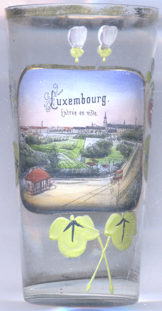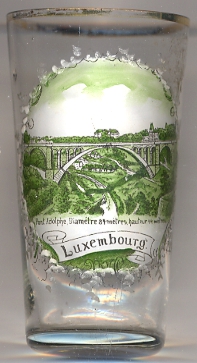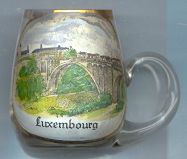

|
|
|
|
|
|
 The city of Luxembourg is the capital of the Grand Duchy of Luxembourg and is located at the confluence of the rivers
Alzette and Pétrusse.
The old quarters of the city of Luxembourg and its fortifications were listed as a UNESCO World Heritage site in 1994.
The city of Luxembourg enjoyed the status of European City of Culture 1995, and it was also selected to be European Capital of Culture for 2007
(together with Sibiu, Romania).
The municipality has a population of about 119,200 (2019). It is also the centre of the canton of the same name and, until
2015 when the three administrative districts of Luxembourg were dissolved, also was the seat of the district Luxembourg.
The city of Luxembourg is the capital of the Grand Duchy of Luxembourg and is located at the confluence of the rivers
Alzette and Pétrusse.
The old quarters of the city of Luxembourg and its fortifications were listed as a UNESCO World Heritage site in 1994.
The city of Luxembourg enjoyed the status of European City of Culture 1995, and it was also selected to be European Capital of Culture for 2007
(together with Sibiu, Romania).
The municipality has a population of about 119,200 (2019). It is also the centre of the canton of the same name and, until
2015 when the three administrative districts of Luxembourg were dissolved, also was the seat of the district Luxembourg.
In the Roman era, a fortified tower guarded the crossing of two roman roads that met at this site. Through an exchange treaty with the abbey of St. Maximin in Trier in 963, Siegfried of the Ardennes, a close relative of King Louis II of France and Emperor Otto I the Great of the Holy Roman Empire, acquired the feudal lands of Luxembourg. Sigfrid built his castle, named Lucilinburhuc ("small castle"), mentioned for the first time in the aforementioned exchange treaty. Since about the late 11th century the counts called themselves Counts of Luxembourg. In 1354 Luxembourg became a Duchy. The House of Luxembourg provided five German Kings and Emperors of the Holy Roman Empire: Heinrich VII (1308 German King, 1312–1313 Emperor), Karl IV (1346/1349 German King, 1347 King of Bohemia, 1355 King of Italy, 1355–1378 Emperor, 1365 King of Burgundy), Wenceslaus (1363–1419 King of Bohemia, 1376–1400[dep.] Roman King), Jobst of Moravia (1410–1411 German King, often not counted), and Sigismund (1378–1388 and 1411–1415 Elector of Brandenburg, 1387 King of Hungary and Croatia, 1410 German King, 1419 King of Bohemia, 1433–1437 Emperor). John of Luxembourg was King of Bohemia 1311–1346. The city, for reasons of its location and natural geography, has through history been a place of strategic military significance. The first fortifications were built as early as the 10th century. By the end of the 12th century, as the city expanded westward, new walls were built that included an area of 5 hectares. In about 1340 new fortifications were built that stood until the dismantlement of 1867. In 1443, the Burgundians under Philip the Good conquered Luxembourg. Luxembourg becomes part of the Burgundian, and later Spanish and Austrian empires. By the 16th century, Luxembourg was one of the strongest fortifications in Europe. Subsequently, the Burgundians, the Spanish, the French, the Spanish again, the Austrians, the French again, and the Prussians conquered Luxembourg. The Austrians, who occupied Luxembourg from 1715 to 1795, further expanded the fortifications to withstand a possible French assault. In the 17th century, the first casemates were built: 23 km of galleries and rooms. They served as storage places for artillery, shelters from enemy fire and allowed the movement of troops between the inner and outer fortifications. The Congress of Vienna in 1815 declared the 'independence' of Luxembourg and elevated it to a Grand Duchy. However, the coutry was to be ruled by the King of the Netherlands in a personal union. At the same time Luxembourg also was made a fortress of the German Federation and Prussian troops were stationed in the town. In 1830 Luxembourg participated in the Belgian Revolution and as a consequence the western half of the country was ceded to the new Kingdom of Belgium in 1839. The so-called Luxembourg Crisis, where Napoléon III had tried to purchase Luxembourg, lead to the Second Treaty of London which in 1867 declared Luxembourg independent and neutral. With the death in 1890 of Willem III, the last male member of the House of Nassau-Orange, the House of Nassau-Weilburg (now Luxembourg-Nassau) acceded to the throne in Luxembourg. During World War I and again during World War II Luxembourg was occupied by German forces; in 1942 it was even annexed to the Third Reich followed by rude attempts of 'Germanisation' which caused deep and long-lasting animosities against Germany within the population.

 The
The  Pont Adolphe was built in 1900–1903 and spans the valley of the river Pétrusse.
At the time of its construction, the bridge was the world's largest stone arch bridge. Its two parallel central arches
have a span width of 84.5 metres and cross the valley 42 metres above the river. The total length of the bridge
is 153 metres. Because it was the second bridge across the Pétrusse in Luxembourg city, the bridge also is refered
to as the "New Bridge". The bridge is named for Grand Duke Adolphe who reigned between 1890 and 1905. Adolphe was the first
Grand Duke of Luxembourg and was Duke of Nassau from 1839 until the annexation of his former country by Prussia in 1866.
Pont Adolphe was built in 1900–1903 and spans the valley of the river Pétrusse.
At the time of its construction, the bridge was the world's largest stone arch bridge. Its two parallel central arches
have a span width of 84.5 metres and cross the valley 42 metres above the river. The total length of the bridge
is 153 metres. Because it was the second bridge across the Pétrusse in Luxembourg city, the bridge also is refered
to as the "New Bridge". The bridge is named for Grand Duke Adolphe who reigned between 1890 and 1905. Adolphe was the first
Grand Duke of Luxembourg and was Duke of Nassau from 1839 until the annexation of his former country by Prussia in 1866.
![[scale]](lineal.jpg)